|
MONDAY EDITION December 15th, 2025 |
|
Home :: Archives :: Contact |
 |
Global "Oil Shock" Rattles World Stock marketsGary Dorsch, Editor, Global Money TrendsMarch 14, 2008 editor@sirchartsalot.com Cleaning up the mess that Mr Greenspan left behind was never going to be easy. Banks and brokers around the world face more than half-trillion dollars in write-offs as a consequence of the US sub-prime mortgage crisis, which is spreading from the US property market and roiling global stock markets. It’s toppled the US economy into a recession and the tremors are also rattling Asian stock markets. Roughly $7 trillion has been wiped from world stock markets since the beginning of the year amid fears of a severe US economic recession and financial institutions reporting more mega losses. “The market crisis will preoccupy us well into 2008,” he said German Finance Minister Peer Steinbrueck on Feb 15th. “The financial risks securitized by banks contained packaged explosives,” and he accused rating agencies of having a conflict of interest in the role they played in the process. So far, the Bernanke Federal Reserve has pumped more than half-a-trillion dollars into the markets with open market operations and special emergency lending schemes, to help cushion the blow to the US economy and stock markets. However, there’s evidence that the Fed’s prescription for dealing with the sub-prime debt crisis, is actually making matters much worse, and leading to “Stagflation.” As the Fed’s rate cuts and massive money injections filter through the financial system, it weighs heavily on the US dollar, and in turn, a weaker dollar inflates huge bubbles in the global commodities markets. Fund managers have already poured an estimated $200 billion into commodities across the board, as a hedge against the explosive growth of the world’s money supply, competitive currency devaluations, and the negative interest rates engineered by central banks. 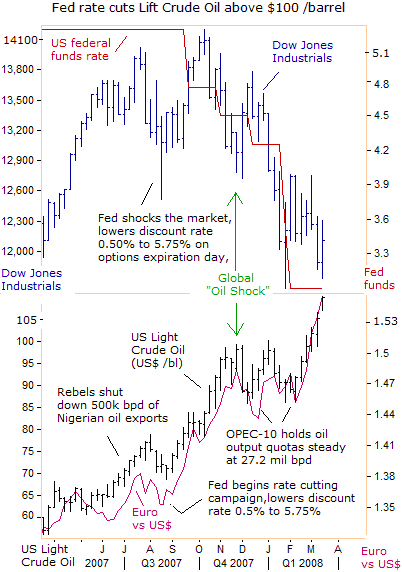 The price of crude oil was trading near $70 a barrel as recently as last August, when the Fed suddenly jolted the markets, by lowering its discount rate to 5.75% on Aug 17th, timed to squeeze short sellers in the stock market, on options expiration day. The Fed’s abrupt shift towards easy money fueled a 1,500-point rally for the Dow Jones Industrials over the next two months to a record high of 14,100. But the stock market’s “irrational exuberance” didn’t last long, once the unintended consequences of the Fed’s rate cuts, a - Global “Oil Shock” – began to settle in. In trying to rescue the Dow Jones Industrials from the claws of a grizzly bear market, the Fed has sacrificed the US dollar, and in turn, ignited a powerful surge in the price of crude oil to $110 /barrel. And most US recessions in the post-World War II era were preceded by sudden spikes in oil prices. On Feb 15th, Fed chief Ben Bernanke played down the threat of spiraling energy and food prices, saying “inflation expectations remain reasonably well anchored,” then signaled another rate cut in March, as an “insurance policy to head off an economic recession.” Since then, the price of crude oil has surged $17 /barrel, and is wrecking havoc on Wall Street and other major stock markets around the globe. 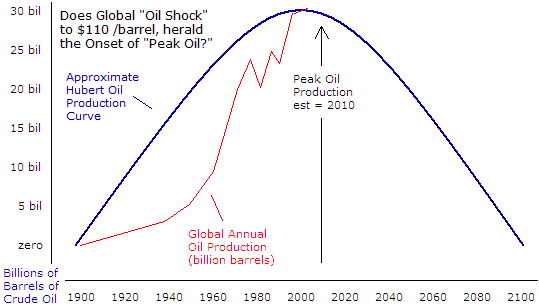 Global investors are plowing money into crude oil, because the longer-term fundamentals are bullish. The International Energy Agency is predicting that global oil demand will rise 2% this year to a record 87.5 million barrels per day. And a growing number of oil investors subscribe to the “Peak Oil” theory that holds to the belief that the global oil supply has already maxed out at 85 million per day. The “Peak Oil” theory refers to the inevitability of a peak in global oil production. Oil is a finite, non-renewable resource, and once half of the original reserves are depleted, oil production is likely to stop growing and then begin a terminal decline. Of the 65 largest oil producing countries in the world, 54 are past their “Peak Oil” production and are now in decline, including the USA, down 11% since 1971, and the UK’s North Sea down 27% since peaking in 1999. Other big oil producers in decline include Australia, down 26% since 2001, and Norway, down 13% since 2001. The Cantarell oil field, Mexico’s largest has also peaked with its output falling to 1.7 million bpd in 2007, down from its peak output of 2.1 million bpd. Thus, global oil demand is expected to exceed supply in the second half of this year, and the oil deficit will only grow wider in 2009, unless the global economy sinks into a sharp recession. 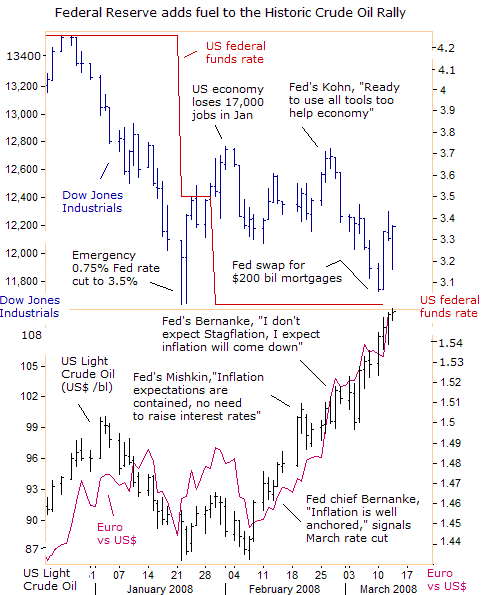 It’s increasingly obvious that the Fed is targeting the stock market, and is trying to put an artificial floor under the Dow Jones Industrials at the 11,650 level, similar to central bank intervention in the foreign exchange market. “We have the tools,” said Fed deputy Donald Kohn on Feb 26th. “As Chairman Bernanke often emphasizes, we will do what is needed, to respond to difficult times,” he said. But former US Treasury secretary Robert Rubin was once asked by his boss Bill Clinton, if he could be re-incarnated, what would he like to be? Rubin replied, “The bond market, because it controls everything.” Nowadays, the “bond vigilantes” are asleep in a coma, and unlikely to be resurrected anytime soon. Emerging in their place however, are the “crude oil vigilantes” who jack up the price of “black gold,” whenever the Bernanke Fed turns up the printing presses. Thus, attempts by the Bernanke Fed to jig up the stock market with a money injections, are short-circuited, by the “crude oil vigilantes”. And the OPEC cartel recognizes the Fed’s sleight of hand, and wants to be compensated for a weaker US dollar, with higher oil prices. “The oil market will stay above $100 during the current financial year,” said OPEC chief Chakib Khelil on March 10th. “The factors driving the market include speculation, geopolitical tensions, particularly the Iranian nuclear affair, and the crisis between Venezuela and Exxon-Mobil,” he said. However, “oil prices could retreat in 2009 with a recovery of the US dollar in foreign exchange markets and the election of a new US president.” Shanghai Red-chips Rattled by “Peak Oil”China emerged as an economic superpower amid the fastest industrial revolution the world has ever seen. China’s economy has grown at 10% or more a year since the 1990’s, and is expected to surpass Germany to become the world’s biggest exporter, after sales of $1.2 trillion abroad in 2007, and reaping a staggering $262 billion trade surplus. China alone contributed 20% of the world’s economic growth last year. It only took the Shanghai red-chips slightly more than 2-years to gain 500% from below 1,000 in June 2005 to above 6,000, while the Nasdaq bubble returned 240% in less than two years to reach the record of 5,000 in March 2000. The Shanghai index reached a P/E ratio of 68, identical to the Nasdaq’s P/E right before the tech-bubble burst. The combined market capitalization of the Shenzen and Shanghai exchanges hit a high of $3 trillion dollars, or 115% of China’s $2.6 trillion GDP. 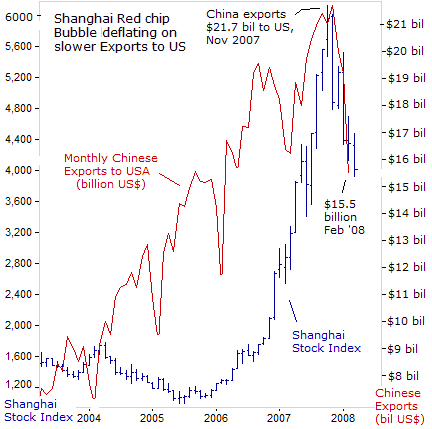 Chinese exports to the US have been a key driver behind the highly volatile Shanghai red-chip market. Exports to the US peaked at a record $21.7 billion last November, but then tumbled to $15.5 billion in February. Chinese exports typically fall sharply in February, during the New Year holiday, when factories close for at least two weeks. But for the first time this decade, Chinese exports to the US were 5% lower on a year-over-year basis, indicating that an economic recession in the United States is beginning to chip away at demand for Chinese exports. But China’s Achilles heel is its voracious appetite for oil. China accounted for half the rise in global oil use this decade. Its industrial revolution led by construction and manufacturing, is highly energy-intensive, and a major reason why crude oil is above $100 a barrel. But with crude oil and other commodity prices spiraling higher, its mammoth trade surplus is narrowing, exporter profit margins are shrinking, and China’s economic output is descending into single digits. 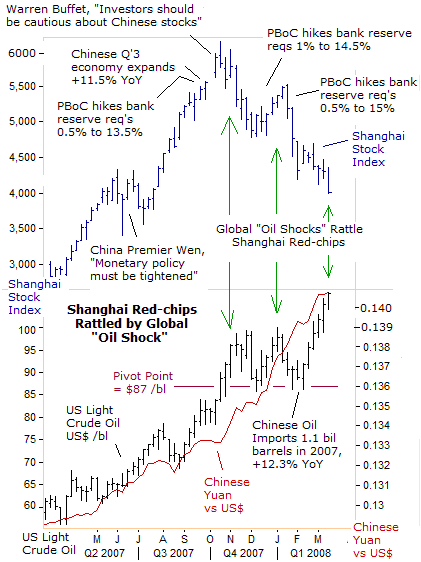 China ranks as the world’s #2 oil consumer after the US, and demand is expected to grow 500,000 bpd annually in coming years, driven by industrial growth and consumer demand as incomes rise. China imported 1.1 billion barrels in 2007, up 12.3% from the previous year. China supplied its fuel needs for decades from domestic fields but rising demand made the country a net importer in the late 1990’s. Imports now account for 50% of consumption. India and China are two Asian giants that consume only a third as much oil as the US today. But if the Chinese and Indians consumed as much oil per capita as Americans do, the world’s oil demand would be closer to 200 million bpd, instead of 85 million barrels today. And with the world running on a limited cushion of Saudi spare capacity, any interruption in supplies from Mexico, Nigeria, or hurricanes and talk of armed conflict with Iran, causes oil prices to spike higher. 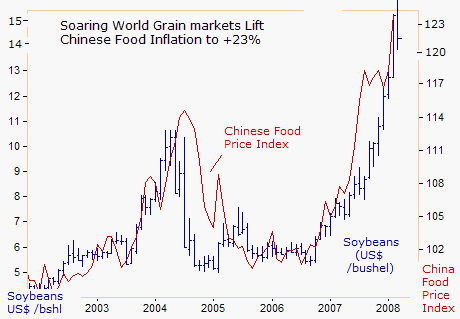 While China’s more affluent classes are nervously watching their savings erode in the stock market, the rest of the population is watching its purchasing power erode from soaring food prices. China’s annual consumer price inflation surged to 8.7% in February, the highest since May 1996, from 7.1% in January. Food prices, which make up a third of the consumer basket, were 23.3% higher in February from a year earlier, compared with an increase of 18.2% in the 12-months to January. Beijing is in a quandary on how best to fight inflation, since a tighter monetary policy won’t produce an extra grain of rice nor an extra bushel of corn. Yet if food inflation stays too high for too long, it could ignite non-food inflation, and social unrest, since the average Chinese household spends 37% of its disposable income on food. For now, Beijing is allowing the yuan climb at a faster rate against the US to hold down import prices, and is aggressively draining excess cash from the Shanghai money markets thru open market operations. Still, the Bernanke Fed is fueling higher oil prices around the world with its cheap dollar policy, and the Global “Oil Shock” is rattling Shanghai red-chips. South Korea Stuck in “Stagflation” TrapHigh prices of crude oil and raw materials are posing a serious threat to resource-deficient South Korea, with slowing growth raising the specter of “Stagflation,” a toxic combination of stagnation and inflation. Local manufacturers are striving to secure raw materials amid soaring prices, but troubles may worsen, putting a heavy burden on the nation’s import-dependent economy. With high-flying prices of crude oil, iron ore, and coal, South Korean imports of raw materials last year hit $201.7 billion, up 16% from $173.9 billion recorded a year earlier, and more than half of the nation’s total imports. South Korea’s raw material imports, which stood at $79 billion in 2000. Higher oil prices could swing the external current account to a deficit of -$7 billion this year, the biggest gap since 1997, from a surplus of +$5.9 billion in 2007, the Finance Ministry said. 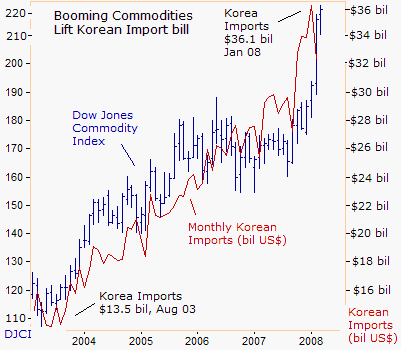 But Korea is also the world’s fourth-largest crude oil buyer, and depends entirely on imports to meet its oil needs. A doubling of oil prices from a year ago has already contributed to a 20% slide in the Kospi blue chips. South Korean import prices were 21.2% higher in January from a year earlier, the most in more than 9-years, adding to inflation pressures, even as the economy is set to run out of steam. The surge in import prices were led by a whopping 48.7% gain for raw materials. To help the local economy and stock market cope with the doubling in crude oil prices to 110,000-won /barrel, the Bank of Korea, (BoK) is rapidly inflating its money supply, - morphine to ease the pain of the Global “Oil Shock.” Korea imported 80 million barrels of crude in January, up 12.3% from a year earlier, but its bill soared 78% to $7.3 billion. The average price of imported Dubai crude stood at $89.6 per barrel in January, up from $56.6 in the same month last year. 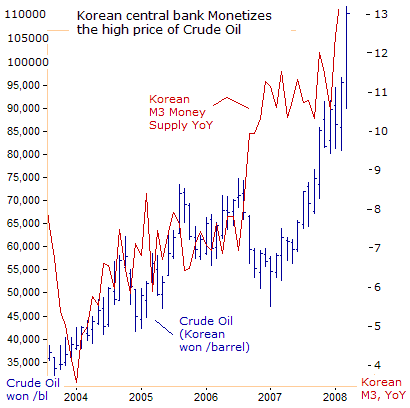 The clandestine practice of “monetizing” higher oil prices is back-firing, since it simply fuels even higher prices for energy, food and other key commodities. On March 7th, Bank of Korea warned that chances have increased for inflation to exceed its previous forecast. “You may think the slowing global economy would help to ease inflation pressures, but there are no signs in sight that the high pace of growth in crude oil and grains prices will turn around soon.” BoK chief Lee indicated that South Korea is sliding into the “Stagflation” Trap. “Chances have increased both for economic growth to fall and price growth to get higher. International prices of crude oil and grains are now growing faster than we had forecast several months ago. Whether the BOK will move as markets expect depends on the future consumer price and economic trends. I can say clearly is that we manage the rate policy in the belief that rate increases will slow money growth and that rate cuts will boost money growth,” Lee said. Global Oil Shock Rattles Tokyo, as dollar hits 100-yenFor most of this decade, Japan’s ministry of finance, has worked tirelessly to defend the US dollar against the yen, to support exports overseas and artificially inflate multi-national income earned in the US. Exports drive almost 20% of Japan’s economy. Half of Japan’s shipments overseas are settled in US dollars even though China and Hong Kong overtook the US as Japan’s largest export market in 2007. In the past, Tokyo usually intervened in the market to defend the dollar at 106-yen, which is the average break-even level for most Japanese exporters. The Bank of Japan, acting on behalf of the MoF, sold a record 20.4 trillion yen ($199 billion) in 2003 and 14.8 trillion yen in the first quarter of 2004, when the yen traded as high as 103.42 per dollar, the biggest intervention stint in history. The dollar also fell towards 100-yen in 1999, 2000, and again in 2003, prompting Japan’s central bank to massively sell the yen each time. But Fujio Mitarai, chairman of the Japan Business Federation (Keidanren), told a news conference on March 10th, that Japanese exporters should be able to cope with dollar/yen exchange rate around 105-yen. “I don’t think we will call for intervention for a while, as long as exchange rates stay around present levels,” Mitarai said. Then on March 13th, Japanese finance chief Fukushiro Nukaga didn’t threaten to intervene on behalf of the dollar as it fell to 101-yen, prompting nervous traders to quickly dump the greenback to the psychological 100-yen level. 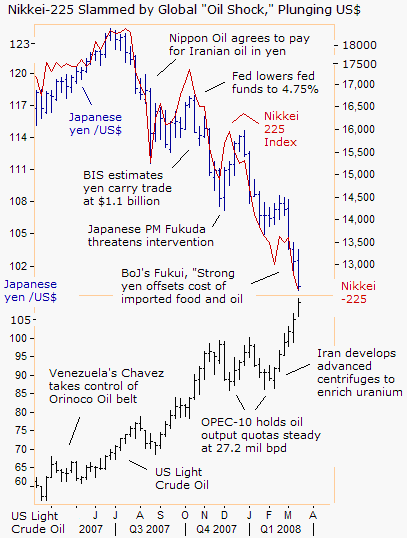 Japan imports almost all of its oil, and is the world’s third-largest oil consumer after the United States and China. Tokyo has striven in vain for decades to reduce its dependence on oil from the volatile Middle East and thereby insure stable supplies by diversifying oil sources. But in 2006, Japan imported 4.2 million bpd, with 88.6% originating from the Middle East. Japan also imports 65% of its food consumption. Traders are wondering whether Tokyo has adopted a new stance on the dollar /yen exchange rate, and is ready to live with a stronger yen, to hold down the costs of imported food and oil. On Feb 22nd, BoJ chief a Toshihiko Fukui said he was paying close attention to how rising food and gasoline prices could affect personal consumption, which makes up roughly half of Japan’s economy. “A stronger yen will ease any negative effect from rising costs of crude oil and commodities,” he said. “The yen’s rise, a decline in the dollar, and rises in oil prices are beginning to have a negative effect on corporate profits,” warned Japanese Economics Minister Hiroko Ota on march 11th. The dollar slid as low as 99.77 yen, breaking below the 100 level for the first time since November 1995. Already this year, the dollar has tumbled 10% against the yen, and is fast approaching the point at which many Japanese exporters say they won’t be profitable. The negative impact from a weaker dollar has already knocked the Nikkei-225 index 20% lower to a 2-year low. “The factors we must monitor with utmost caution in guiding monetary policy are stock and exchange rate movements,” said Bank of Japan member Atsushi Mizuno on Feb 28th. “If such high volatility continues, it could hurt the real economy through worsening corporate and consumer sentiment. Given that Japan’s recovery is an external-demand-led one backed by exports, downside risks are heightening on mounting risks to US growth,” he warned. Gary Dorsch, Editor, Global Money Trends March 14, 2008 editor@sirchartsalot.com To stay on top of volatile markets, subscribe to the Global Money Trends newsletter today, for insightful analysis and predictions of the future for the (1) top stock markets around the world, (2) Commodities such as crude oil, copper, gold, silver, and gold mining and oil company indexes (3) Foreign currencies (4) Libor interest rates, global bond markets and central bank monetary policies, and (5) Central banker "Jawboning" and Intervention techniques that move markets. GMT filters important news and information into (1) bullet-point, easy to understand analysis, (2) featuring "Inter-Market Technical Analysis" that visually displays the dynamic inter-relationships between foreign currencies, commodities, interest rates and the stock markets from a dozen key countries around the world. Also included are (3) charts of key economic statistics of foreign countries that move markets. Subscribers can also listen to bi-weekly Audio Broadcasts, with the latest news on global markets, and view our updated model portfolio for Q’1, 2008. To order a subscription to Global Money Trends, click on the hyperlink below, http://www.sirchartsalot.com/newsletters.php or call toll free to order, Sunday thru Thursday, 8 am to 9 pm EST, and on Friday 8 am to 5 pm, at 866-553-1007. Outside the US call 561-367-1007. This article may be re-printed on other internet sites for public viewing, with links required to, http://www.sirchartsalot.com/newsletters.php Mr Dorsch worked on the trading floor of the Chicago Mercantile Exchange for nine years as the chief Financial Futures Analyst for three clearing firms, Oppenheimer Rouse Futures Inc, GH Miller and Company, and a commodity fund at the LNS Financial Group. As a transactional broker for Charles Schwab's Global Investment Services department, Mr Dorsch handled thousands of customer trades in 45 stock exchanges around the world, including Australia, Canada, Japan, Hong Kong, the Euro zone, London, Toronto, South Africa, Mexico, and New Zealand, and Canadian oil trusts, ADR's and Exchange Traded Funds. He wrote a weekly newsletter from 2000 thru September 2005 called, "Foreign Currency Trends" for Charles Schwab's Global Investment department, featuring inter-market technical analysis, to understand the dynamic inter-relationships between the foreign exchange, global bond and stock markets, and key industrial commodities. Copyright © 2005-2008 SirChartsAlot, Inc. All rights reserved. Disclaimer: SirChartsAlot.com’s analysis and insights are based upon data gathered by it from various sources believed to be reliable, complete and accurate. However, no guarantee is made by SirChartsAlot.com as to the reliability, completeness and accuracy of the data so analyzed. SirChartsAlot.com is in the business of gathering information, analyzing it and disseminating the analysis for informational and educational purposes only. SirChartsAlot.com attempts to analyze trends, not make recommendations. All statements and expressions are the opinion of SirChartsAlot.com and are not meant to be investment advice or solicitation or recommendation to establish market positions. Our opinions are subject to change without notice. SirChartsAlot.com strongly advises readers to conduct thorough research relevant to decisions and verify facts from various independent sources. |
| Home :: Archives :: Contact |
MONDAY EDITION December 15th, 2025 © 2025 321energy.com |
|